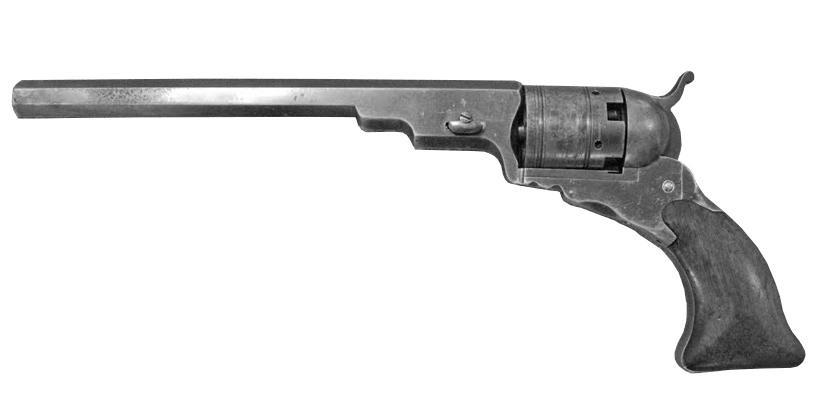Samuel Colt and His Revolver

On July 19, 1814, Samuel Colt was born in Hartford Connecticut. His parents were textile manufacturers. Through observing the equipment in the textile mill, Samuel gained an intimate knowledge of mechanical devices. He also spent time disassembling all the mechanical objects he could in order to understand how they worked.
Around age 11, Samuel was indentured to a farmer who also provided an education to Samuel as a benefit. During this time he gained access to a scientific encyclopedia named the “Compendium of Knowledge,” in which he discovered writings about gunpowder, Robert Fulton and other inventors of the like. Samuel was fascinated and inspired by the imposing engineering accomplishments that Fulton and the other inventors overcame and set his mind on emulating them.
Samuel enrolled to study navigation at Amherst Academy in Massachusetts around the age of 16, but he was soon expelled for accidentally causing a fire at the school. As a result, his father decided to complete Samuel’s education in navigation by sending him out to sea for a year on a ship named the “Corvo.” While at sea, the idea of how to make a single-action weapon capable of firing multiple shots one after another, occurred to him. Volley guns, which fired multiple barrels simultaneously, existed during this time, such as the duck-foot pistol.
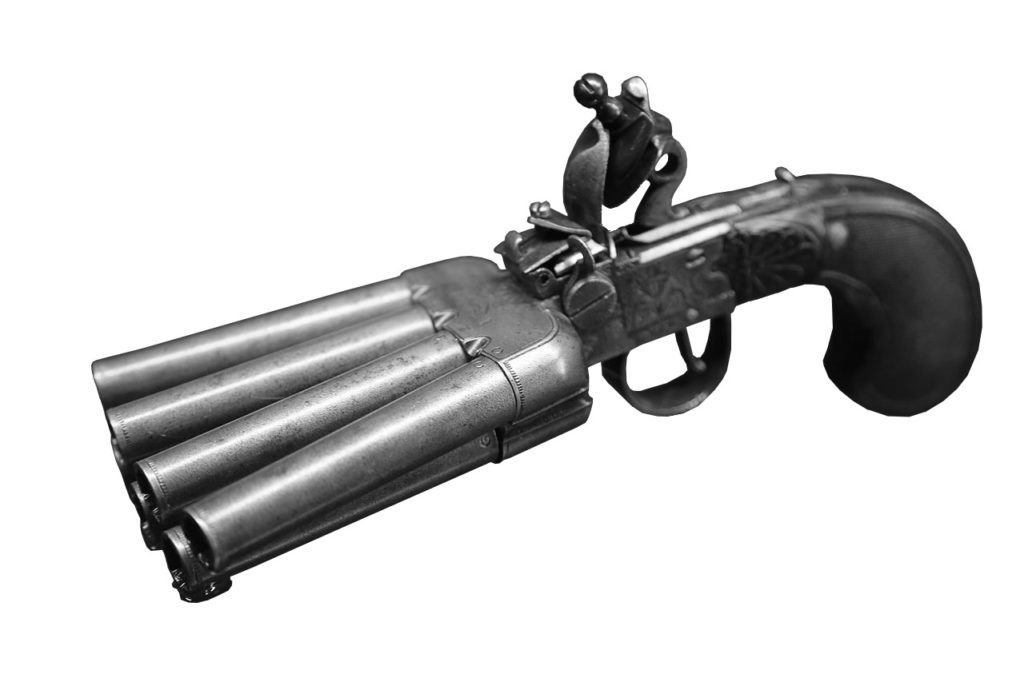
Other guns also had multiple barrels, each having their own trigger, while some were like the pepperbox revolver that required the user to manually rotate the barrel assembly on the gun after each shot.
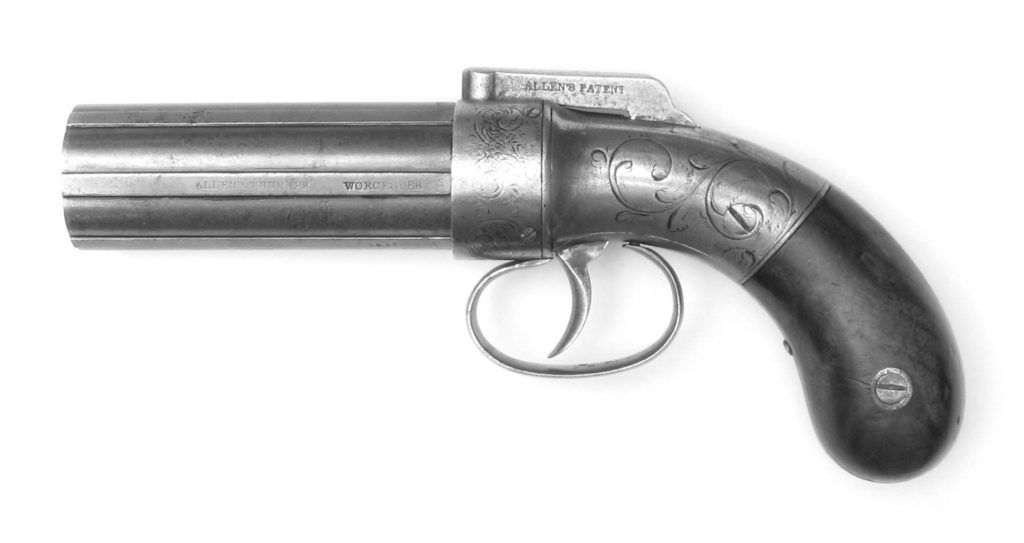
Samuel was inspired by the ratchet and pawl mechanism on the ship’s windlass, which allowed it to rotate and lock into position. Samuel’s inventive imagination went to work as he envisioned a pepperbox styled pistol with a barrel assembly that rotated automatically into the next firing position when the hammer was cocked through the use of a mechanism based off the windlass’s ratchet and pawl. While on the ship, Samuel fabricated a model of a six barreled pistol that would index and rotate out of a piece of scrap wood.
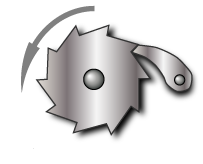
Returning to the United States after his voyage at sea, Samuel convinced his father to fund the manufacturing of a pistol and a rifle for testing purposes. The resulting firearms test had mixed results in that the rifle performed as intended, but the pistol exploded. After making the first prototype guns his father refused to provide anymore funding towards the cause. Consequently, Samuel had to find new avenues to procure funding in order to develop his guns. Fortunately for Samuel, the chemist from his father’s textile mill taught him about nitrous oxide, commonly known as laughing gas. For the next two years, Samuel would derive income for future gun development by promoting himself as Dr. Coult on a traveling road show promoting the uses of laughing gas. After raising sufficient funding, Samuel once again focused his attention to developing his invention. As he continued to refine his invention he had the idea of reducing the weight of the pistol by using a rotating cylinder that would align with a single barrel. A gunsmith by the name of John Pearson helped refine and make Colt’s revolver.
Samuel sought out a United States (US) patent on his invention, but was advised that he should procure protection in the United Kingdom (UK) first. Due to nuances in the laws of the US and the UK at the time, Samuel would be barred from obtaining patent protection in the UK if he applied for a US patent first. As such, Samuel headed off to the UK to seek patent protection on his invention. Much to his chagrin, he ran into head winds with the English patent office. In 1818, an inventor from Boston named Elisha Collier obtained a UK patent for a flintlock revolver that was similar in nature to Samuel’s gun.

After much hesitancy, UK patent office finally issued patent (6909) to Samuel for his invention in 1835.
Upon receiving patent protection in the UK, Samuel returned to the US and filed for a US patent. On February 25, 1836, Samuel was awarded US patent US9430X. The US9430X patent differed from Collier’s gun in that Samuel’s used percussive caps placed on hollow nipples that connected to the rear of each chamber in the cylinder; whereas, Collier’s invention used a flint to discharge a pan of powder to set off the chamber.
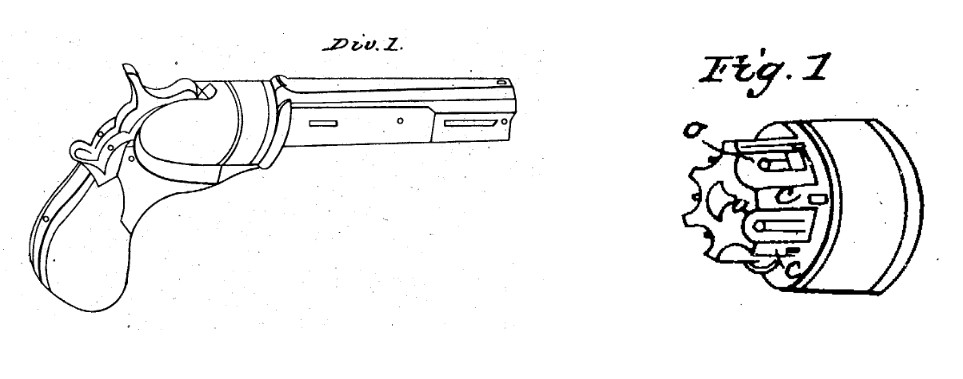
Additionally, Samuel’s invention also protected the gun’s powder from getting wet from the rain or humidity since the chamber was sealed with a percussive cap and the chance of chain fire, caused from one chamber flashing over to another, was reduced.
Colt started production of his first commercial repeating pistol in Paterson, New Jersey, and it became known as the Paterson revolver. The revolver began as a .28 caliber five shot pistol, but later evolved into .36 caliber. Though the Paterson revolver was a great leap forward in firearm technology, it still had some quirks. For instance, the revolver lacked a loading lever to press bullets into the cylinders, making it necessary to partially break down the pistol in order to reload it. Additionally it lacked a trigger guard and had a folding trigger that only appeared when the pistol was cocked. Also it lacked a capping window which made it necessary to remove the cylinder to put the percussive caps into place. Later, to address these deficiencies on the Paterson revolver, Samuel would incorporate a loading lever, fixed trigger and a capping window.
Samuel Colt issued into the world the first practical pistol capable of repeating fire and a patent enforcing his intellectual property rights for almost two decades. He would go on to form the Colt’s Manufacturing Company which would produce many other guns such as the Colt Walker, the Colt Single Action Army pistol, also known as the “Peacemaker,” the Colt Python, and the Colt M1911 pistol, as well as many others. The world was changed when a teenage boy had a fire of inventive innovation ignited within him from seeing a windlass, and the unbreakable tenacity to make his dreams into reality.


